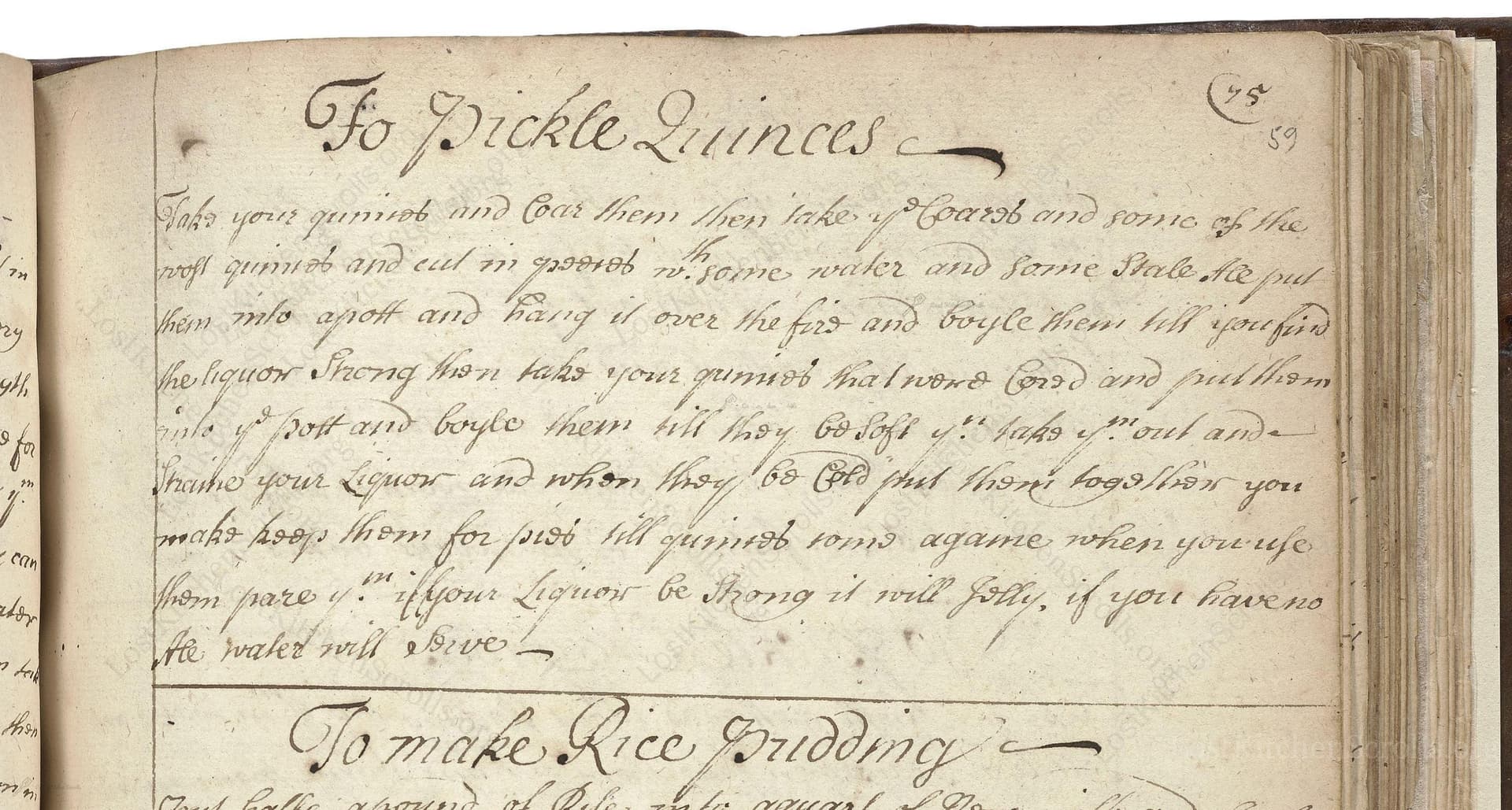To Pickle Quinces
From the treasured pages of Cookbook of Grace Blome, Kent
Written by Grace Randolph

To Pickle Quinces
"Take your quinces and Car them then take half of your quinces and cut in peeces put them in some water and some Salt & put them into a pott and hang it over the fire till the liquor strong then take your quinces whole & into ye pott and boyle them till they be Soft enough Shaike your Liquor and when they be Cold put them together you may keep them for pies till quinces come againe when you use them pare it. if your Liquor be Strong enough it will Jelly. if you have no Sea water will serve."
Note on the Original Text
The recipe is written in a conversational, straightforward style, without precise measurements or times—a hallmark of early modern cookery writing. Spelling is variable and reflects speech: 'Car' means 'peel'; 'boyle' is 'boil'; 'pott' for 'pot'; and 'liquor' means cooking liquid. The brevity assumes the reader is already familiar with preservation basics—a reminder that these were working instructions for experienced cooks rather than absolute beginners.

Title
Cookbook of Grace Blome, Kent (1697)
You can also click the book image above to peruse the original tome
Writer
Grace Randolph
Era
1697
Publisher
Unknown
Background
A delightful glimpse into late 17th-century kitchens, this culinary collection by Grace Randolph tempts taste buds with refined recipes and elegant flavors fit for a well-to-do English household. Journey through a banquet of historic treats and timeless techniques!
Kindly made available by
Folger Shakespeare Library
This recipe hails from late 17th- to early 18th-century England, recorded by Grace Randolph in the year 1697. During this period, preserving fruit for winter was essential, and pickling was a practical—and delicious—solution. Quinces were prized for their tart flavor and high pectin content, making them ideal for long-term storage in a salty, lightly fermented brine. This method allowed households to enjoy quince pies and sweets long after the harvest season was over. Collections like these, often compiled by women running large households, were central to English domestic life—a testament to culinary ingenuity and resourcefulness.

Back in the late 1600s, this recipe would’ve required some sturdy kitchen basics: a sharp paring knife for peeling and 'carring' the quinces, a large earthenware or cast-iron pot for simmering, a wooden spoon for stirring, and a cool pantry (or cellar) for storing the pickled fruit in ceramic jars. Open hearths or simple stoves provided the heat, and stoneware or glass jars were essential for preserving.
Prep Time
15 mins
Cook Time
30 mins
Servings
6
We've done our best to adapt this historical recipe for modern kitchens, but some details may still need refinement. We warmly welcome feedback from fellow cooks and culinary historians — your insights support the entire community!
Ingredients
- 2.2 lb quinces, peeled (or peeled and halved)
- 4 1/4 cups water (or enough to cover quinces)
- 1 oz coarse salt (or substitute with sea salt or table salt)
Instructions
- Begin by peeling (carring) your quinces — about 2.2 lb of fresh fruit is a good start.
- Take half the quinces and cut them into small pieces.
- Place these pieces in a pot with about 4 1/4 cups of water and 2 tablespoons (1 oz) of coarse salt.
- Bring this to a simmer to prepare a strong, slightly briny liquor.
- Once the liquid is flavorful, add the remaining whole, peeled quinces to the same pot.
- Simmer gently until the whole quinces are just soft enough when pressed, about 20–30 minutes.
- Remove the quinces and allow everything to cool.
- Once cooled, store the quinces submerged in their briny liquor in a glass jar or non-reactive container.
- The liquor may gel slightly, creating a natural jelly, particularly if the quinces are very ripe and high in pectin.
- To use the quinces later (especially for pies), simply drain and peel as needed.
- If sea salt isn’t available, use table salt: the original allows table salt or even seawater as substitutes!:
Estimated Calories
90 per serving
Cooking Estimates
You will spend about 15 minutes peeling and preparing the quinces. Cooking them to the right tenderness takes another 30 minutes. Each serving has about 90 calories, and you'll get around 6 servings from the recipe.
As noted above, we have made our best effort to translate and adapt this historical recipe for modern kitchens, taking into account ingredients nowadays, cooking techniques, measurements, and so on. However, historical recipes often contain assumptions that require interpretation.
We'd love for anyone to help improve these adaptations. Community contributions are highly welcome. If you have suggestions, corrections, or cooking tips based on your experience with this recipe, please share them below.
Join the Discussion
Rate This Recipe
Dietary Preference
Main Ingredients
Culinary Technique

Den Bockfisch In Einer Fleisch Suppen Zu Kochen
This recipe hails from a German manuscript cookbook compiled in 1696, a time whe...

Die Grieß Nudlen Zumachen
This recipe comes from a rather mysterious manuscript cookbook, penned anonymous...

Ein Boudain
This recipe comes from an anonymous German-language manuscript cookbook from 169...

Ein Gesaltzen Citroni
This recipe, dating from 1696, comes from an extensive anonymous German cookbook...
Browse our complete collection of time-honored recipes



